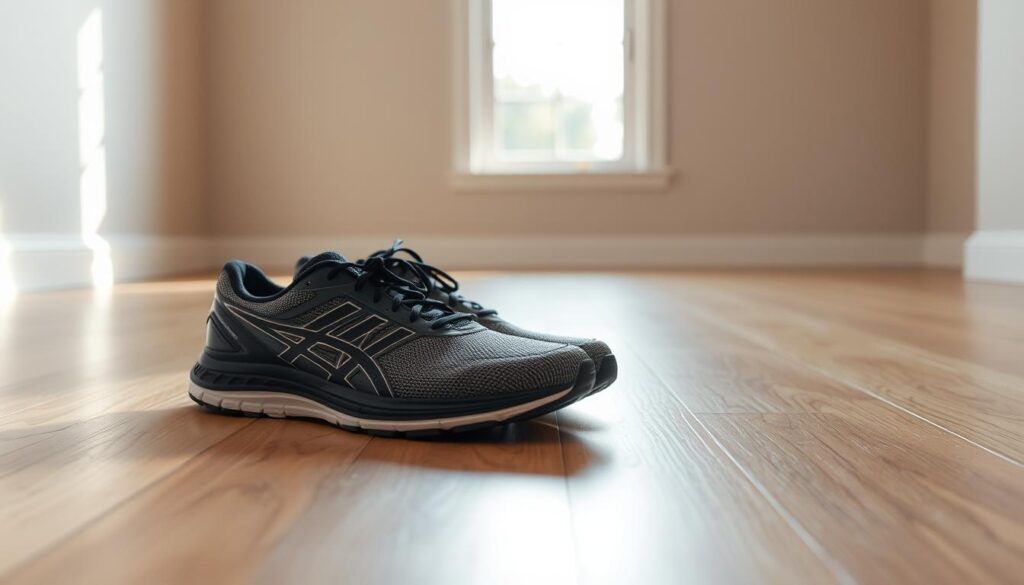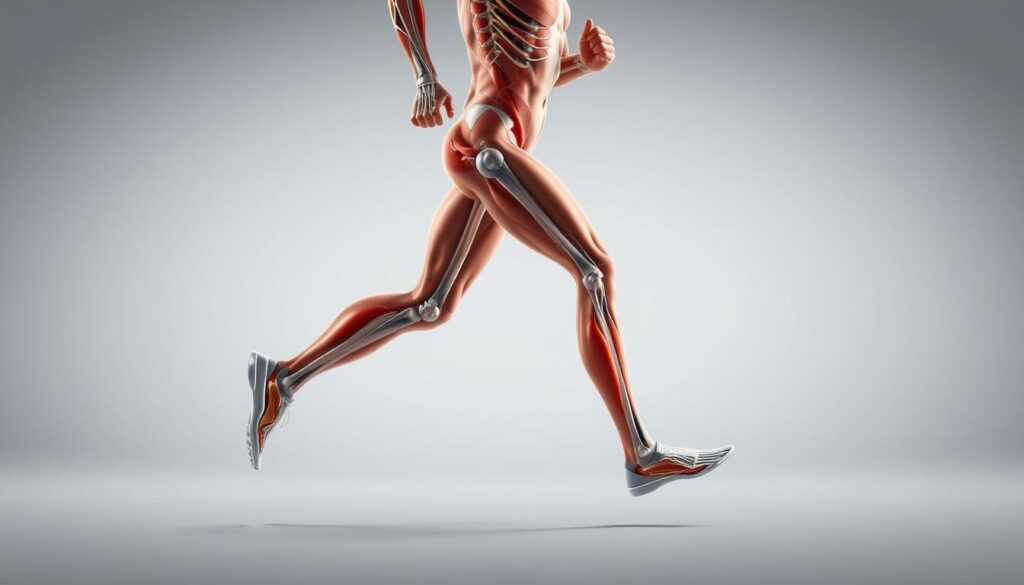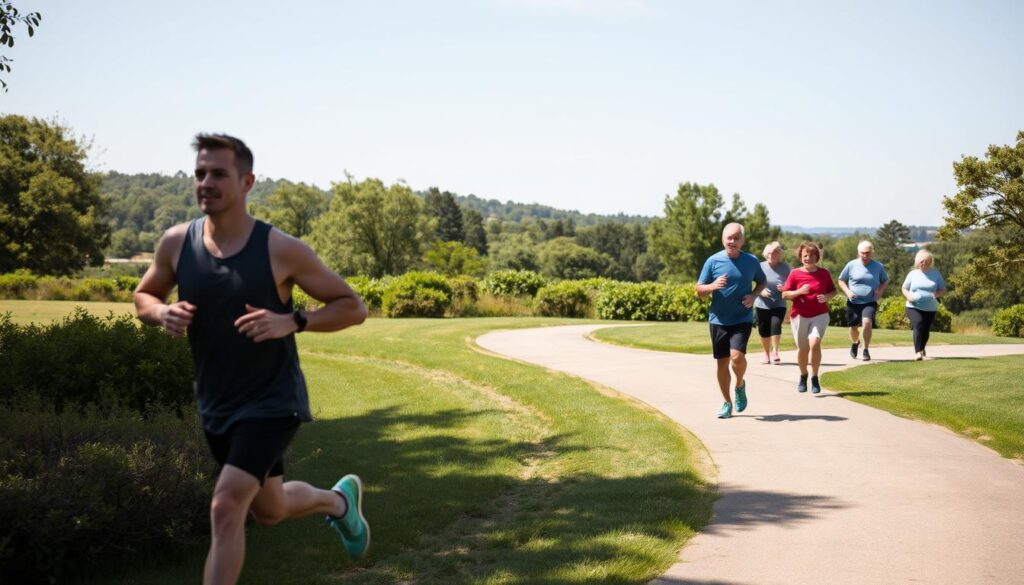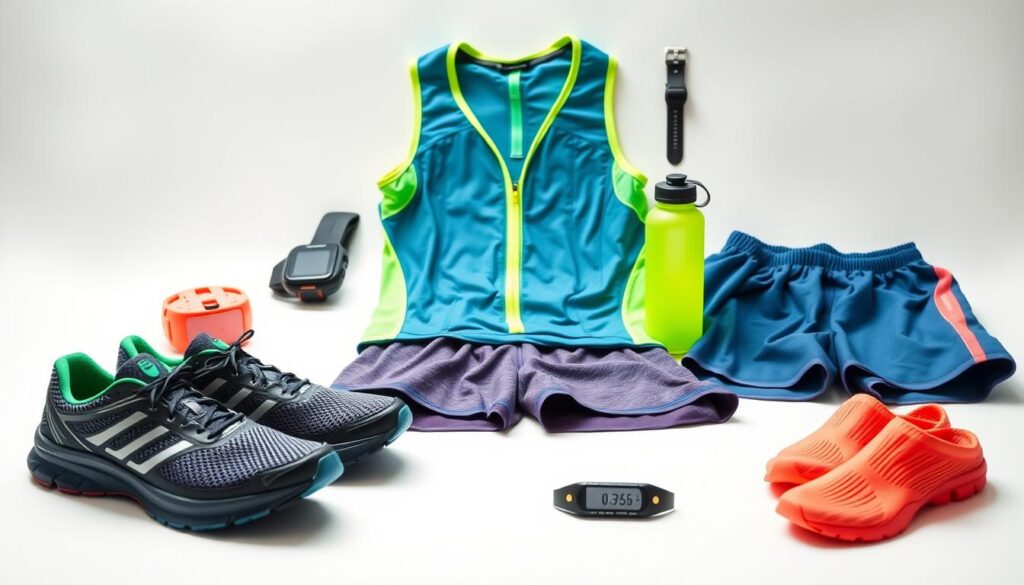Discover the joy of running and unlock its numerous benefits for your overall health and fitness. Running is a simple yet effective form of exercise that requires minimal equipment, making it accessible to people of all fitness levels.
As one of the most accessible forms of exercise, running offers a range of benefits, from improving cardiovascular health to boosting mental well-being. This comprehensive guide is designed for beginners, covering the fundamentals of running, including proper form, essential gear, and training schedules.
By understanding how running affects your body and incorporating it into your lifestyle, you can achieve your fitness goals, whether it’s weight management, stress reduction, or improved overall health.
Key Takeaways
- Running is an accessible form of exercise for people of all fitness levels.
- Proper form and technique are crucial for a safe and effective running experience.
- Running offers numerous health benefits, including improved cardiovascular health and mental well-being.
- A well-structured training schedule can help beginners gradually build their endurance.
- Investing in the right gear can enhance your running experience and prevent injuries.
What Makes Running an Ideal Exercise for Beginners
For those new to exercise, running stands out as a highly accessible and effective form of physical activity. It requires minimal equipment and can be done almost anywhere, making it an ideal choice for beginners.
The Accessibility of Running as a Sport
Running is a sport that is accessible to everyone, regardless of age or fitness level. Its simplicity is one of its most significant advantages, as it doesn’t require any special equipment or membership fees. You can run almost anywhere, whether it’s in your neighborhood, local park, or on a treadmill at home.
The flexibility of running is another benefit. You can run at any time that suits you, whether that’s early in the morning, during your lunch break, or in the evening. This flexibility makes it easier to incorporate running into your daily routine.

Equipment Needed to Get Started
While running is relatively low-cost, there are a few essential pieces of equipment that you’ll need to get started. The most important of these is a good pair of running shoes that provide adequate support for your foot type. When selecting running shoes, focus on finding a pair that offers proper support rather than opting for trendy brands or flashy designs.
- Quality running shoes are the only essential investment for beginners.
- Moisture-wicking clothing can help manage sweat and prevent chafing.
- Optional accessories include a sports watch, a comfortable hat, and a water bottle.
While specialized running gear exists, beginners should prioritize comfort and functionality over expensive equipment until they’ve established a consistent running routine. The key is to start with the basics and gradually add more gear as you become more comfortable with your running habit.
The Science Behind Running
Delving into the mechanics of running reveals the intricate science that governs this popular form of exercise. Running is a complex activity that involves the coordination of multiple bodily systems to achieve optimal performance and fitness.

Understanding the Running Gait
The running gait refers to the pattern of movement of a runner’s body as it interacts with the ground. It involves a repetitive cycle of stance and swing phases, with the footstrike being a critical element that can affect efficiency and injury risk. Understanding one’s running gait can help in optimizing running technique, thereby enhancing performance and reducing the risk of injury.
As runners adapt to different terrains and intensities, their gait adjusts accordingly, showcasing the body’s remarkable ability to adapt. This adaptation is crucial for improving fitness levels and overall health.
How Your Body Responds to Running
When you engage in running, your body responds by initiating several physiological changes. The heart rate increases to supply more oxygen to the muscles, which are the primary movers in this activity. Over time, regular running leads to improvements in cardiovascular efficiency, enhancing aerobic capacity.
- Running stimulates mitochondrial development within muscle cells, enhancing energy generation and endurance.
- The impact forces from running stimulate bone density increases, strengthening the skeletal system.
- The nervous system adapts by improving coordination between muscle groups, making movements more efficient.
- Regular running triggers hormonal responses that improve mood and reduce stress.
These adaptations underscore the comprehensive benefits of running for overall health and fitness. By understanding how the body responds to running, individuals can better appreciate the value of incorporating this exercise into their lifestyle.
Health Benefits of Running
Incorporating running into your lifestyle can have significant health advantages. Running is a simple yet effective way to improve overall health and increase life expectancy. By understanding the various benefits associated with running, individuals can better appreciate the positive impact it can have on their well-being.

Cardiovascular Improvements
Running is known to bring about substantial cardiovascular improvements. Regular runners often experience a reduction in high blood pressure and a decrease in the use of medications to lower blood pressure and plasma cholesterol levels. Studies have shown that long-distance runners can have a nearly 50% reduction in high blood pressure, contributing to a healthier cardiovascular system.
Key cardiovascular benefits include:
- Improved heart health through increased cardiovascular efficiency
- Enhanced circulation, which aids in the delivery of oxygen and nutrients
- Reduced risk of heart disease due to lower blood pressure and cholesterol levels
Mental Health Benefits
Running also has a profound impact on mental health. The physical activity associated with running stimulates the production of endorphins, often referred to as “feel-good” hormones. This can lead to improved mood and reduced stress levels. Moreover, the sense of accomplishment from regular running can boost self-esteem and confidence.
The mental health benefits of running are multifaceted:
- Reduced symptoms of anxiety and depression
- Improved mood through the release of endorphins
- Enhanced cognitive function and clarity
Long-term Health Outcomes
The long-term health outcomes associated with running are equally impressive. Research consistently shows that regular runners live longer, with studies indicating an average life expectancy increase of 3-7 years compared to non-runners. Running helps maintain a healthy body weight, improves fat metabolism, and reduces obesity-related health risks.
Long-term benefits include:
- Better cognitive function as individuals age, potentially delaying or preventing age-related cognitive decline and dementia
- A stronger immune system, reducing the frequency and severity of common illnesses
- Better bone density maintenance, reducing the risk of osteoporosis and fractures in later years
By incorporating running into their lifestyle, individuals can experience these benefits firsthand, leading to a healthier and more fulfilling life.
Running for Weight Management
When it comes to weight management, incorporating running into your routine can be a game-changer. Running is not only an effective way to burn calories but also offers a comprehensive workout that engages multiple muscle groups, contributing to overall fitness and weight loss.
Calorie Burning Potential
Running is renowned for its high calorie-burning potential. A 30-minute run can burn between 200 to 500 calories, depending on intensity and individual factors. This makes it an efficient exercise for those with busy schedules looking to maximize their calorie expenditure in minimal time.
Several factors contribute to the calorie-burning effectiveness of running:
- Running engages your core stabilizers and upper body, in addition to leg muscles, creating a full-body workout.
- The weight-bearing nature of running stimulates bone density improvements, adding to its overall benefits.
- Running outdoors can further increase caloric expenditure due to wind resistance and terrain variations.

Running vs. Other Exercises for Weight Loss
While various exercises can aid in weight loss, running stands out due to its unique benefits. For instance, a study comparing fat burning during running, uphill walking, and cycling found that fat burning was 28% higher during running and uphill walking than during cycling.
Some key advantages of running over other forms of exercise for weight loss include:
- Running may suppress appetite temporarily through hormone regulation, aiding in calorie control.
- Unlike stationary exercises like cycling or swimming, running engages multiple muscle groups simultaneously.
- The impact stress from running can stimulate improvements in bone density, a benefit not typically associated with low-impact exercises like swimming.
In conclusion, running offers a potent combination of calorie burning, muscle engagement, and metabolic benefits that make it an ideal exercise for weight management. By incorporating running into your fitness routine, you can achieve significant weight loss and improve overall health.
Getting Started with Running
Embarking on a running journey can be both exhilarating and intimidating, but with the right mindset, you can set yourself up for success. As you begin, it’s crucial to lay a solid foundation that will help you stay motivated and committed to your fitness goals.

Setting Realistic Goals
Setting goals is a fundamental step in your running journey. It’s essential to identify your personal “why” for running—whether it’s improving health, managing stress, losing weight, or challenging yourself. By understanding your motivations, you can create a clear plan tailored to your needs.
To stay motivated, set small, achievable milestones. For example, aim to run a certain number of days per month or gradually increase your continuous running time. Celebrating these small victories will help you stay engaged and motivated.
Creating a Beginner-Friendly Schedule
Creating a schedule is vital to establishing a consistent running habit. As a beginner, it’s essential to start with a manageable routine that allows your body to adapt. Begin with a mix of running and walking to avoid burnout and prevent injuries.
Plan your runs in advance, taking into account your time constraints and other commitments. Consistency is key, so try to run at the same time every day or week to make it a habit.
Finding Your Motivation
Staying motivated is crucial to maintaining your running routine. According to Meyer, “Whenever I’m in the middle of a really hard workout, I remember, ‘You chose this, and you really love this.'” Reflecting on your reasons for starting can help you push through challenging moments.
“Even when it gets hard, there’s a reason you got out in the first place.”
To maintain your motivation, consider the following strategies:
- Identify your personal “why” and keep it visible through notes or reminders.
- Find accountability through running partners or online communities.
- Create rewards for reaching your running milestones.
- Connect your running to a meaningful cause, such as charity events or virtual races.
By implementing these strategies, you’ll be better equipped to stay motivated and enjoy the many benefits that running has to offer for your overall health and fitness.
The Run-Walk Method for Beginners
One of the most effective ways for beginners to start a running routine is by using the run-walk method, which alternates between running and walking. This approach allows individuals to gradually build up their endurance and confidence, making it a more manageable and less intimidating way to start running.

Benefits of Interval Training
The run-walk method is a form of interval training, which has several benefits for beginners. By alternating between running and walking, individuals can improve their cardiovascular fitness, increase their endurance, and boost their mental health. Interval training also allows for a more efficient workout, as it enables individuals to push themselves during the running segments while recovering during the walking segments.
For example, a beginner might start with a routine that involves running for three minutes and walking for one minute, repeating this cycle for a total of 20-30 minutes per session, three times a week. This type of interval training can be adjusted based on individual progress and comfort level.
Sample Run-Walk Programs
Here are some sample run-walk programs for beginners:
- Week 1-2 Program: Begin with 1 minute of running followed by 2 minutes of walking, repeated for 20-30 minutes total, performed 3 times per week.
- Week 3-4 Program: Progress to 2 minutes of running with 2 minutes of walking, maintaining the same 20-30 minute total workout time, 3 times weekly.
- Week 5-6 Program: Advance to 3 minutes running with 1 minute walking intervals, potentially extending total workout time to 25-35 minutes as fitness improves.
- Week 7-8 Program: Implement 5 minutes running with 1 minute walking, focusing on maintaining consistent effort throughout each running segment.
- By weeks 9-10, many beginners can attempt 10 minutes of continuous running alternated with 1 minute walking breaks, gradually building toward longer continuous running periods.
Proper Running Form and Technique
Mastering the art of running begins with understanding the intricacies of proper form and technique. Good running form is essential for efficiency, performance, and injury prevention. It involves a combination of proper body positioning, movement, and breathing techniques.

Head and Upper Body Positioning
Maintaining the correct posture starts with your head and upper body. Keep your head up, looking forward, and avoid tilting it down or up. Your ears, shoulders, and hips should be aligned. Relax your shoulders and keep them down, avoiding tension. This posture helps in maintaining a straight spine and opens up your chest for better breathing.
Arm and Hand Movement
Your arms play a significant role in your running technique. Keep them relaxed and bent at around 90 degrees. Avoid clenching your fists or holding your hands too far away from your body. Instead, let your arms swing naturally by your sides, which helps in maintaining a rhythm and reducing unnecessary energy expenditure.
Lower Body Mechanics
Your lower body is directly involved in propelling you forward. Ensure that your feet land midfoot or forefoot instead of heel striking, which can cause excessive impact. Keep your stride natural and avoid overstriding, which can lead to braking and increased risk of injury. Maintain a quick turnover to keep your body moving efficiently.
Breathing Techniques
Effective breathing is crucial for maintaining a steady supply of oxygen. To improve your breathing technique:
- Focus on deep, rhythmic breathing that engages your diaphragm rather than shallow chest breathing.
- For beginners, breathing through both your nose and mouth maximizes oxygen intake.
- Coordinate your breathing with your running cadence using patterns like inhaling for 2-3 steps and exhaling for 2-3 steps.
- Practice belly breathing (diaphragmatic breathing) to increase oxygen capacity.
- If you experience side stitches, focus on deep exhales and slowing your pace temporarily.
By focusing on these aspects of your runningtechnique, you can improve your overallrunningexperience, making it more efficient and enjoyable.
Choosing the Right Running Shoes
Finding the right running shoes involves understanding your foot type, running style, and personal preferences. With the numerous options available, selecting the perfect pair can be overwhelming. However, by considering a few key factors, you can make an informed decision that enhances your running experience.
Understanding Your Foot Type
Your foot type plays a significant role in determining the right shoes for you. There are generally three foot types: neutral, flat, and high arch. Understanding your foot type will help you choose shoes that provide the necessary support and stability. For instance, if you have flat feet, you’ll need shoes with more substantial arch support to prevent overpronation.
To determine your foot type, you can perform a simple wet test. Wet your feet and stand on a flat surface. The shape of your footprint will indicate your foot type. If you have a complete impression, you likely have flat feet. If there’s a narrow connection between the heel and ball, you have a neutral foot type. If there’s little to no connection, you have high arches.
Key Features to Look for in Running Shoes
When selecting running shoes, several key features should be considered to ensure comfort and performance. Here are some essential factors to look for:
- Prioritize proper fit with a thumb’s width of space between your longest toe and the shoe’s end. Shoes that are too small can cause blisters and black toenails.
- Look for adequate cushioning in the midsole that feels comfortable during a test run but isn’t so soft that it compromises stability.
- Ensure the shoe has appropriate flexibility at the forefoot where your foot naturally bends, while providing sufficient support through the midfoot.
- Consider the shoe’s weight; unnecessarily heavy shoes can increase fatigue during longer runs, though ultra-lightweight shoes may sacrifice durability and support.
- Pay attention to the heel counter, which should feel snug but not tight to prevent heel slippage while running.
Additionally, it’s recommended to visit a reputable running-shoe store where knowledgeable staff can help you find the perfect pair. Bring your running socks, try both shoes on, and take them for a test run if possible. Ensure a comfortable fit from the start, as there’s no “breaking in” period for shoes. By considering these factors, you can find the ideal running shoes that meet your needs and enhance your running experience.
Essential Running Gear Beyond Shoes
Beyond a good pair of running shoes, there’s other essential gear that can enhance your running experience. As you continue on your running journey, you’ll find that having the right equipment can make a significant difference in your comfort, performance, and overall enjoyment.

Clothing for Different Weather Conditions
Choosing the right clothing for your runs is crucial, as it can greatly impact your comfort and performance. For hot weather, opt for lightweight, breathable, and moisture-wicking fabrics that will help keep you cool and dry. In colder conditions, layering is key; start with a base layer that wicks moisture away from your skin, followed by insulating layers, and finish with a wind-resistant outer layer.
For runners, having the right clothing can make a big difference. For example, technical fabrics that wick moisture and dry quickly are ideal for running. Additionally, consider clothing with reflective materials or bright colors to increase visibility during early morning or evening runs.
Accessories That Enhance Your Running Experience
Several accessories can significantly enhance your running experience. For instance, GPS watches or smartphone apps can help track your distance, pace, and route, providing valuable data to monitor your progress and adjust your training accordingly. Other useful accessories include properly fitted running socks with moisture-wicking properties to prevent blisters, hydration solutions for longer runs, running-specific sunglasses for eye protection, and anti-chafing products to prevent skin irritation.
- GPS watches or smartphone apps to track your runs and monitor progress
- Moisture-wicking running socks to prevent blisters and discomfort
- Hydration solutions like handheld water bottles or hydration vests for longer runs
- Running-specific sunglasses with lightweight frames and non-slip features
- Anti-chafing products to prevent painful skin irritation during longer runs
Keeping a running journal can also be beneficial, as it allows you to track your progress, note your effort levels, and record any issues you’re experiencing. According to the American College of Sports Medicine, having an exercise partner can improve your motivation and help you stick to your workout routine.
Nutrition for New Runners
As a new runner, understanding the role of nutrition is crucial for optimizing performance and enhancing recovery. Proper nutrition supports the body’s needs during running, helping to prevent fatigue and injury.
What to Eat Before and After Running
Fueling your body appropriately before and after running is vital. Before a run, consume a balanced meal or snack that includes complex carbohydrates and a moderate amount of protein about 1-2 hours beforehand. This helps provide energy and prevent hunger during your run. After running, refuel with a mix of carbohydrates and protein within 30-60 minutes to aid in recovery and muscle repair.
Pre-run snacks could include bananas, toast with peanut butter, or energy bars, while post-run meals might feature grilled chicken with quinoa and vegetables or a smoothie with fruit and protein powder.
Hydration Strategies
Staying hydrated is essential for runners, as it helps regulate body temperature and transport nutrients to cells. Begin your run well-hydrated by drinking 16-20 ounces of water 2-3 hours before running and another 8 ounces right before you start.
For runs under 60 minutes in moderate temperatures, water is typically sufficient. However, for longer or more intense runs, consider using electrolyte-containing sports drinks to replenish lost salts.
It’s also important to recognize early signs of dehydration, such as increased thirst, dry mouth, reduced sweating, and darkened urine color. Practice your hydration strategy during training runs, aiming to consume 4-6 ounces of fluid every 15-20 minutes during longer runs.
After your run, replace lost fluids plus an additional 25-50% to account for continued sweating and urination. For runs over an hour, consider electrolyte replacement to restore the body’s balance.
Common Running Injuries and Prevention
Despite its numerous benefits, running can lead to injuries if proper precautions and training methods are not followed. Runners often face challenges due to the repetitive impact of running, which can cause stress on the muscles, joints, and bones.
Recognizing Warning Signs
The body often sends out warning signs before an injury becomes severe. Recognizing these signs is crucial for injury prevention. Since bones cannot disperse forces easily, the forces are transmitted to other parts of the body, including ligaments, joints, and bones in the lower extremities up to the lower back. This can cause abnormal compensatory motions, such as internal rotation of the tibia, knee, and hip joints, in an attempt to avoid serious bone injuries.
Paying attention to pain that persists or worsens over time is essential. Runners should be aware of:
- Pain that doesn’t improve with rest
- Swelling or inflammation
- Instability or weakness in the joints
- Changes in running form or gait
Preventative Measures and Recovery Tips
To minimize the risk of running injuries, incorporating preventative measures into your training is vital. Here are some effective strategies:
- Follow the 10% rule by increasing your weekly training volume by no more than 10%.
- Incorporate strength training 2-3 times weekly, focusing on core, hip, and leg muscles.
- Practice proper warm-up and cool-down routines, including dynamic stretches before running and static stretches afterward.
- Alternate between different pairs of running shoes to vary stress patterns, and replace shoes every 300-500 miles.
- Implement regular recovery techniques like foam rolling, gentle yoga, or compression gear.
By understanding the causes of common shin and other running injuries and taking proactive steps, runners can enjoy their sport while minimizing the risk of injury.
Progressive Training: Building Endurance Safely
As you start your running journey, it’s crucial to build endurance safely to avoid injuries and burnout. Progressive training allows your body to adapt to the demands of running, making you a stronger and more resilient runners.
The 10% Rule for Increasing Distance
A widely accepted principle for safe progression is the 10% rule, which advises against increasing your weekly running distance by more than 10% each week. This gradual increase allows your muscles, tendons, and cardiovascular system to adapt without excessive stress.
By following this rule, you can minimize the risk of overuse injuries and ensure a steady improvement in your endurance.
Incorporating Rest and Recovery
Recovery is a critical component of training. It’s during rest days that your body repairs and strengthens itself. Scheduling at least one to two complete rest days per week is essential, allowing your muscles, tendons, and joints time to recover.
Additionally, incorporating “active recovery” through low-impact activities like swimming, cycling, or yoga can help maintain fitness while giving your running-specific muscles a break. Paying attention to sleep quality and quantity is also vital, as sleep deprivation can significantly impair recovery and increase the risk of injury.
Running on Different Surfaces and Terrains
As you progress in your running journey, you’ll likely encounter various terrains that challenge your body and technique in different ways. Running on different surfaces, such as roads, trails, and treadmills, requires adaptability and adjustments in your form to maintain efficiency and prevent injuries.
Road vs. Trail vs. Treadmill Running
Each surface has its unique characteristics. Road running is typically smoother and more consistent, making it ideal for speed workouts and long runs. Trail running, on the other hand, involves uneven terrain, hills, and obstacles that demand more attention to footwork and balance. Treadmill running offers a controlled environment, useful for precise pacing and recovery runs. Understanding these differences helps you adjust your technique and training accordingly.
Adjusting Your Technique for Hills
Running on hills requires specific adjustments to your technique. When running uphill, maintain your rhythm and effort level but shorten your stride and slow down as you climb. Lean slightly into the hill from your ankles, increase your arm swing, and focus on pushing off from your toes. For downhill running, let gravity work for you, but stay in control by leaning slightly forward from the ankles and keeping your torso upright. Avoid overstriding to prevent excessive impact and fatigue.
By adapting your running technique to different terrains, you can improve your overall performance and reduce the risk of injury. Practice and patience are key to mastering these adjustments and becoming a more versatile runner.
Tracking Your Progress as a Runner
As you progress in your running journey, tracking your progress becomes essential to achieving your goals. Monitoring your progress helps you stay motivated, identify areas for improvement, and make data-driven decisions to optimize your training.
Useful Metrics to Monitor
To effectively track your progress, focus on metrics that provide valuable insights into your running performance. A training log is an excellent tool for recording various aspects of your runs, such as type, duration, distance, effort level, and how you felt during and after the run. Consider also logging your nutrition, hydration, and sleep quality to understand their impact on your performance.
Some key metrics to monitor include:
- Distance and pace
- Heart rate and cadence
- Elevation gain and loss
- Run type (e.g., interval, hill repeats, long run)
Apps and Tools for Running
Several apps and tools are available to help you track your running progress. GPS tracking apps like Strava, Nike Run Club, and Runkeeper offer a range of features, including route tracking, pace analysis, and community sharing. Running watches from brands like Garmin, Coros, and Polar provide more accurate tracking and additional metrics like heart rate variability.
Other useful tools include music and podcast apps with running-specific features, such as tempo-matched playlists and guided workouts, to help maintain motivation and consistent pacing. Recovery tracking tools like HRV apps can also help optimize your training by measuring your body’s readiness for hard workouts versus recovery days.
Joining the Running Community
Joining a running community can be a game-changer for runners of all levels. It’s an opportunity to connect with like-minded individuals who share your passion for running and can provide support, motivation, and valuable insights.
Finding Running Groups and Events
One of the best ways to get involved in the running community is by finding local running groups and events. These groups often organize runs, training sessions, and social events that are perfect for meeting other runners. You can search online for running clubs in your area or check out local running stores for information on upcoming events.
- Join local running clubs to meet other runners and participate in group runs.
- Attend running events, such as marathons, half-marathons, and fun runs, to challenge yourself and connect with others.
- Look for running groups on social media to stay updated on local running activities.
Online Resources for Runners
In addition to local running groups, there are numerous online resources available for runners. These include websites, YouTube channels, podcasts, and social media groups dedicated to running and training.
- Websites like Runner’s World and Running Magazine offer training plans, nutrition advice, and injury prevention tips.
- YouTube channels provide visual guides on proper running form, strength exercises, and personal running stories.
- Running podcasts cover a range of topics from training methodologies to mental preparation strategies.
- Online forums and social media groups allow you to ask questions, share experiences, and connect with other runners.
By leveraging both local and online resources, you can enhance your running experience, stay motivated, and achieve your running goals.
Conclusion: Embracing Your Running Journey
With every step, you’re not just moving forward; you’re becoming a runner. As you continue on your running journey, remember that it’s a personal path with no fixed timeline. Success is measured by consistency and enjoyment, not speed or distance.
Celebrate your milestones, whether it’s completing your first continuous mile or finishing your first organized race. Each achievement represents meaningful progress on your path to becoming one of the dedicated runners who enjoy the lifelong benefits of running, including mental clarity, stress relief, and a supportive community.
Embrace your identity as a runner from day one, regardless of your pace or the miles you cover. The running community welcomes participants of all abilities. Allow your goals to evolve naturally over time, focusing on what makes running a sustainable part of your lifestyle.
